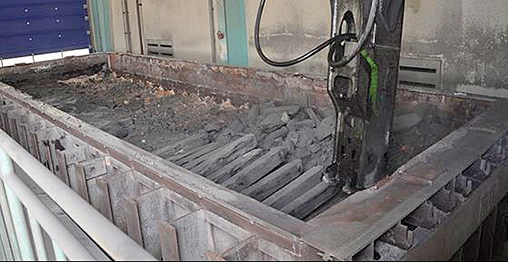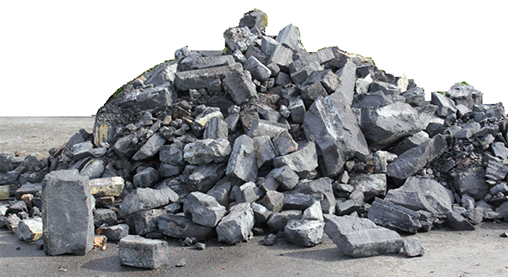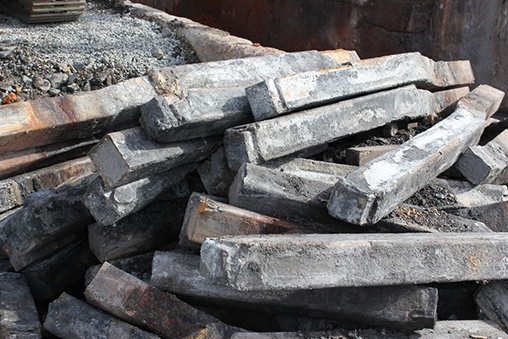
De-Lining Process
Where Qatalum has taken a lead is in the recycling of Spent Pot lining, First Cut (SPL 1) and Second Cut (SPL2). Both SPL 1 and SPL 2 consist of material removed during the de-lining process of cells used in the making of liquid aluminium. The process of de-lining takes place after about 2,000 days of cell operation. De-lining is followed by re-lining of the cells with new insulation, refractory, and cathode block materials. These used materials, make up SPL 1 and SPL 2.
First Cut Spent Pot-Liner SPL 1 comprises of cathode blocks made of carbon, collector bars of steel and Silicon Carbide blocks made up of graphitized carbon.

Cathode blocks made of carbon

Cathode collector bars
As a result of material testing and analysis and after many trials and effort between Qatar Steel and Qatalum it was decided that Qatalum send SPL 1 to Qatar Steel. SPL 1 is then crushed and used as fuel in the electric arc furnace. The spent carbon (in all its sizes and shapes) is now sent to Qatar Steel where it is re-used as re-carburizer and as an energy supplement. Other smelters send their SPL 1 to landfills, keep it in storage at their plant, or, in some countries, use it as energy supplement in cement factories.
This reuse contributes to both environmental and financial gains for Qatalum. Environmentally, the reuse in the steel industry is a sustainable solution by not using a landfill or the costly processes of using chemicals for pre-treatment. The reuse of the SPL 1 process requires no pre-treatment, therefore, causing less environmental impact.
Financially the reuse means huge savings on disposal costs for Qatalum, it generates a marginal revenue and incurs almost no transportation costs. This is due to the proximity of Qatar Steel’s premises to Qatalum’s.
SPL 1 can also be used in the cement manufacturing industry. In order for SPL 1 to be used in cement plants it has to be crushed to about 6mm or smaller pellets and fed pneumatically to the kiln where it is used as an energy supplement. The amount of fluoride within the SPL 1 pellets when used in a controlled manner benefits the concrete’s strength. Published literature shows up to 0.50% by weight of fluoride will increase the concrete strength measured at certain times after installation. Here, extreme care must be taken when adding Fluoride to cement making constituents.
The second cut of Spent Pot-Liner (SPL 2) referred to as ‘Spent Refractories’ consists of Alumina and Silicate originally found in the bricks and Fluoride from the electrolysis process. All materials are normally required in the production of cement clinker. SPL 2 has been ruled non-hazardous by the US EPA (US Environmental Protection Agency). Qatalum is presently supplying the cement factory in Umm Bab with experimental quantities of SPL 2 for use in their process. The project is proving to be a success. Qatalum is presently working closely with the Qatar environmental authorities to proceed with SPL 2 to be consistently supplied to the cement industry.
.png)
Spent Refractories (Second Cut Spent Pot liner SPL 2)
There are several benefits to both Qatalum and the cement industry that can be derived from re-using SPL 2 in cement clinker making. These include SPL 2 as a raw material supplement, it acts as a fluxing agent and strength booster to concrete mixes, requires no increase in harmful emissions, emits no Hydrogen Fluoride and contributes to a reduction in the cement production cost.
The Sustainability and Environment team at Qatalum spent ample time and effort trying to find sustainable solutions to recycling SPL by-products. They worked closely with Qatar Steel and Qatar National Cement Company to perform the testing and initial trials to reuse by-products as raw materials in their steel and cement manufacturing processes. The team, along with all of Qatalum operational groups, under the guidance of Dr. Mufeed Odeh, accomplished the task. Furthermore and most importantly, this endeavour is the first in the region and rarely done globally. Qatalum has, however, proved that SPL 1 and SPL 2 can be safely reused with environmental and economic benefits to all parties.

